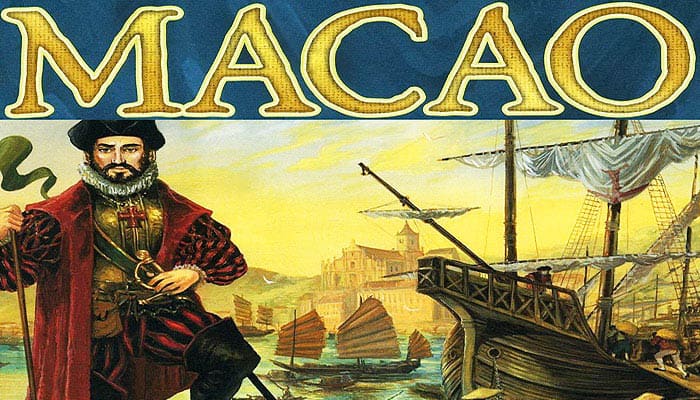
An exciting strategy game for clever captains and wise governors
The players take the roles of influential Portuguese adventurers who risked it all in the 17th century to try their luck in Macao, the trading center in the far east of the time.
By the lucrative trade with Europe, well-planned expansion in the city, and skillful filling of important offices and positions the players increase their reputation and prestige.
Each of the 12 rounds runs as follows: first, each player must select a new card and two of the six dice, which bring him action cubes. Then, the players use the available action cubes to "activate" cards, take possession of a city quarter, move his ship. and deliver goods to Europe.
The player who plans well and uses his action cubes effectively will gain prestige for his foresight and the success it brings him.
The winner is the player who has the most prestige points at game end.
Components

- 1 game board
- 4 player tableaus
- 4 wind roses
- 24 goods tiles
- 6 joker tiles
- 36 gold coins
- 48 ownership/punish marker
- 300 action cubes
- 6 dice
- 4 ships
- 10 discs
- 24 office cards
- 44 building cards
- 52 person cards
Setup
Before the first game carefully remove all the parts from the four die-cut sheets.
-
Place the game board in the middle of the table. It shows the city of Macao, divided into 30 quarters and surrounded by a city wall (with 16 spaces).
Beyond the wall is the ocean with eight European ports (the targets for the trade from Macao) and spaces for the ships. On the left is the tribute track (with spaces from 0-12). At the edge of each of the long sides are places for the 24 office cards.
Around all of this runs the scoring track for the player's prestige points (with spaces from 0-99),
Note: the map is not an accurate depiction of the city of Macao in order to have room for the various mechanics of the game.
-
Each player chooses a color (orange, white, yellow, or brown) and takes the following in his chosen color:
the tableau, which he places near him on the table (his play area). On the left side is a brief overview of the play of a game round; it also has places for up to five cards and also for goods tiles and ownership/punish markers.
the wind rose, which he places next to his tableau. The 7-sided wind rose shows pictures of dice from 1 to 6 and a pointer.
the ship, which he places on one of the ship slips (with anchor).
two discs, which he places on the 0 space of the prestige point track and on the first space (with a pointer) of the city wall (the players stack them in two small stacks).
12 ownership markers, which he places near his tableau with his color side up.
In addition, each player takes 5 gold coins, which he places next to his tableau. A player must always place his coins so that others can see how much he has.
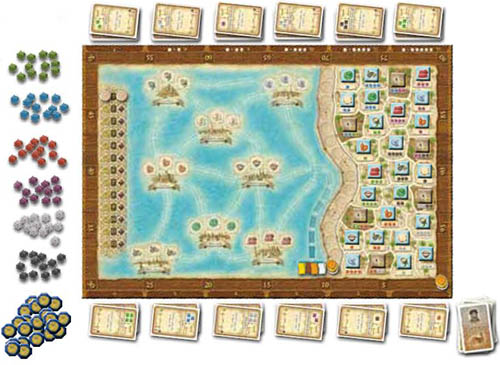
-
Place the remaining gold coins next to the game board as a bank.
-
Sort the 300 action cubes by color and . place them next to the game board.
-
Place the 24 goods tiles randomly (shuffle them and place them as they are drawn) on the houses of the 24 light city spaces and the 6 joker tiles on the houses of the 6 dark city spaces. When placing them, make certain that the tax stamps are recognizable.
-
Separate the 120 cards into two stacks based on the different graphic on their backs:
Shuffle the 24 office cards. Next, place them in sets of two cards each "white player face-up next to the long sides of the game board (the board has marks and numbers showing where to place them). In this way the office cards also serve as round counters.
Shuffle the 96 building/person cards and place them face-down in a stack next to the board next to the first two office cards.
-
Place the two beige discs to the right and left of number "0" on the tribute track on the left side of the board.
-
The players choose one player to be the "dice roller". He takes the 6 dice and places them next to his tableau.
Before beginning the game, the players must do two more things to prepare for the game:
-
From the Building/Person card stack, draw two more cards than the number of players (e.g. 5 cards with 3 players) and place them face-up near the game board.
Beginning with the player whose disc is at the bottom of the stack of discs on the wall and continuing to other players in the order of the discs from bottom to top, each player takes a card and puts it on any empty card space on his tableau.
Place the two unchosen cards on a discard pile next to the supply stack. The order of selecting cards is intended to balance the disadvantage of having a disc lower down on the stack on the wall at the beginning of the game.
For number 2 below and during the rest of the game, the normal turn sequence is front to back along the wall and top to bottom within a stack.
-

Now, starting with the player whose disk is on top of the stack of discs on the wall and moving downward in the stack, each player takes any one action cube (AC) from the general supply and places it next to the 1 die space on his wind rose and then places any two ACs (of the same color, but not necessarily the same as the first cube) from the general supply next to the 2 die space on his windrose.
In this way, the other players perform the same actions with ACs from the general supply, placing them next to their wind roses.
-
Game Play
The game lasts for exactly 12 rounds, with each round running the same way:
- 1st phase: cards
- 2nd phase: dice
- 3rd phase: actions
1st Phase: Cards
First, the dice roller takes the 2 office cards for this round and places them face-up next to the board and then draws from the stack and places the four top-most building/person cards (B/P cards) face-up next to the two office cards for this round.
Next, the "tribute value" is calculated: to do this, the players add all yellow numbers at the bottom left hand corner of the six face-up cards and place the beige disc on the left side of the tribute table on the number matching the sum (the result can be also 0).
Similarly, the players sum the red numbers on the lower right and mark this on the right side of the table (also here the result can be 0). The tribute table shows the exchange value: the number of gold coins (GC) a player must spend to "buy" how many prestige points (PP).
Example: with the following 6 cards, the tribute shows a player can spend 3 (gold coins) to buy 6 (prestige points).
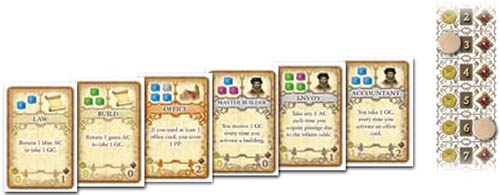
Depending on the number of players, the players now remove 0-2 of the face-up building/person cards (and discard them): with 4 players, remove no cards; with 3 players, remove the last drawn B/P card; and with 2 players, remove the last two drawn B/P cards. Office cards are not removed.
Now, the first player on the wall must choose one of the face-up cards and place it on his tableau. This card is reserved for this player and to be used later (see below, point 3.1). Then, the other players follow in the order of their discs on the wall, each taking a card and putting it on his tableau. After all players have taken cards, discard the two remaining cards cards.
Note:
The activated idler card changes the preceding rule.
The players may search through the discard pile at any time.
Note: In the course of the game, it can occur that a player's tableau has five cards when he acquires a sixth card. In this case, the player must discard any of his now six cards so he has only five cards on his tableau. As a consequence of this, he receives a punish marker, i.e. he turns one of his ownership markers over so the -3 is showing and places in the space provided on his tableau (see left).
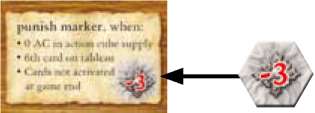
2nd Phase: Dice
The dice roller now rolls all six dice and arranges them so that all those with the same pips showing are together: all 1s, all 2s together etc.
Subsequently, the players take turns in wall order*. Each chooses any two dice (not taking them) and takes the numbers of action cubes of that color from the supply and places them next to the number matching the pips on the die on his wind rose.
Note (*): the players may choose to execute this phase simultaneously, choosing their two dice and taking the AC at the same time. However, if one or more players want to see what others choose before making their choices, the phase is played in the normal wall order.
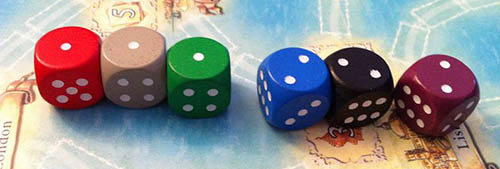
Example: the player rolls the dice 2 and 5 among others. Each player who chooses these two dice, takes 2 red AC, placing them next to the picture of the 2 die on his wind rose, and 5 green AC, placing them next to the picture of the 5 die.
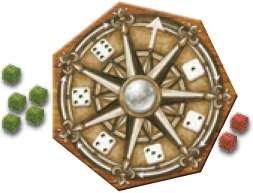
After the players take their AC, each rotates his wind rose one space in the clockwise direction. Thus, each of his AC move to a die with 1 fewer pip. The pile of AC, which the arrow now points to (= the AC of the previous die 1), become the player's "action cube supply" which he may use when executing the following actions.
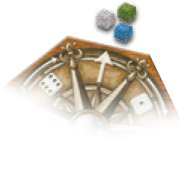
All other AC which are next to the dice spaces on his wind rose remain where they are, but are not considered part of his action cube supply and may not be used as such.
Note: if, after rotating his wind rose, the arrow points to a space with no AC, the player, as consequence of this, receives a punish marker, i.e. he turns one of his ownership markers over so the -3 is showing (as above).
Note: in the 3rd phase, such a player may have already activated cards that would enable him to place AC in the space next to the arrow on his wind rose. In this case, he would then have action cube supply he could use (see below).
Of course, even without action cube supply, the player could use 3.5 for the "acquisition of prestige", as this does not use his action cube supply.
3rd Phase: Actions
In the actions phase, the players execute actions using their action cube supply.
Players should try to use all their action cube supply, since the player must return any unused action cube supply not used back into the general supply at the end of the phase, i.e. players may not keep any AC in the space next to the arrow on their wind roses for the next round.
The player first on the wall begins and uses (if possible) his actions supply cubes to execute the following described actions in any combination and order. Afterwards, the second player on the wall follows and does the same, and so on, until all players have taken their turns executing actions.
The Actions
Activate cards
(based on AC colors available)
In order to use a card on his tableau, a player must activate it by putting exactly the combination of AC that are shown at the top of the card from his supply of action cube supply back into the general supply.
Then, he takes the card from his tableau and puts it in his play area; from now on the card is activated for the remainder of the game and may be used "free of charge" without limit (including in the round it was activated).
A player may activate as many of his cards in his turn as he wants and has AC in his action cube supply to do so. He can activate cards, do other actions, and then activate more cards, as he chooses.
Take possession of one city quarter
(based on AC colors available)
The city is divided into 30 quarters. At the beginning of the game, each quarter has either a goods tile or a joker tile.

In order to take possession of a quarter, a player must put exactly the AC shown in this quarter from his supply of action cube supply back into the general supply. Then, he exchanges the tile on the quarter for one of his ownership marker.
(At game end, each player will score points for his longest chain of connected ownership markers in the city; see game end).
Once a quarter has been taken by a player, that ownership marker remains for the rest of the game. That quarter cannot be taken again (even by the same player).

The player places the goods tile on the picture of the ship on his tableau so that all can see it. This good is now on that player's ship (regardless of where the ship is!).
When a player takes a joker tile, he places it next to his Tableau. He can use it any time in the game (including
immediately after he gets it), to either put any AC from the general supply into his supply of action supply cubes or take 3 GC from the bank. After using the joker, he discards it next to the game board out of the game.
Remember: each player may only take possession of one city quarter in each round.
Note: the (activated) cards: fountain, juggler, herald, night watchmen, smithy, soldier, speculator, and carpenter change the preceding rules. The activated juggler, for example, doubles each joker tile so that each can be used to take any 2 AC, 1 AC and 3 GC, or 6 GC.
Move forward once on the wall
(AC colors are unimportant)
The player can move his disc forward along the wall once per round. For each one AC (any color) that the player pays from his action cube supply to the general supply, he moves his disc forward one space along the wall.
After moving his disc one space, he can move it further by returning any two AC for each one further space he moves his disc along the wall. If a player moves his disc to a space with one or more other discs, he puts his on top.
Note: In the very rare case that a player pays enough AC to move his disc to (or beyond) the last space on the wall, he places his disc on the bottom! (of the stack, if there are others there) of the last wall space.
If another player later moves his disc to (or beyond) the last wall space, he puts it on the bottom, as well.
The (activated) cards: fountain, cannoneer, gate, tower, and guard change the preceding rules.
Ship Move
(AC colors are unimportant)
On his turn, a player may move his ship as often and as far, with any number of direction changes as he wants along the sea and port spaces. For each space he moves his ship (each port counts as a space) the player must return one AC (of any color) from his action cube supply to the general supply.
Any number of ships may occupy a sea or port space at the same time.
When a player's ship is in a port, he may unload any goods tiles he has on his ship that match the goods wanted by that port. He places the tile(s) on the highest empty spaces available at the port (delivering goods does not cost the player AC!).
Then, he moves his disc on the prestige point track to record the points scored (the numbers on the spaces where he places the ware tiles.
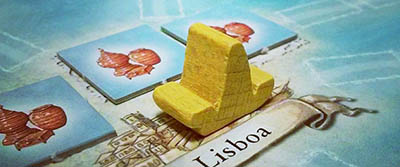
Note:
If a player's ship is in a port that wants a goods tile he just acquired by taking possession of a city quarter, he may immediately deliver the ware to the port as normal for no AC cost and score prestige points accordingly.
The activated cards cooperage, captain, all 8 warehouses, lighthouse, cabin boy, sail maker, and helmsman change the preceding rules.
The prestige points earned by the cooperage are NOT doubled by warehouses!
Acquire Prestige Points Once
(paid for by GC, not AC)
Once in each turn a player can acquire prestige points directly by buying them with GC. The purchase costs is defined by the current position of the discs on the tribute table. The player pays the required gold coins to the bank and moves his disc on the prestige track accordingly.
Note: the activated cards message, diplomat, and envoy change the preceding rule.
Use Cards
On his turn, a player may use the function of any number of his activated cards, and may use them at any time in his turn, and in any order. Of course, some functions are only possible at certain times and he may only use each card once per turn (unless otherwise specified).
Pass
When a player cannot or chooses not to perform further actions in a turn, and still has AC in his action cube supply, he must return all these AC to the general supply.
Example of a turn: a player can first activate one or more cards, then move his ship (and use cards related to ship movement), use other cards, take possession of one city quarter (and use related cards), activate more cards, move his ship again, and finally acquire prestige (and use related cards).
All combinations and sequences are possible, but remember that three actions are allowed only once per turn (per player): move forward on the wall, pay GC to add PP, and take possession of a city quarter.
Dice Phase
Beginning with the 8th round, fewer die values are useful (this happens as there is no longer time for the wind roses to reach these numbers).
Therefore in the 8th round all rolled 6's are turned directly to the 1; in the 9th round, all 6's and 5's are turned to 1's, so that in the 12th round, all rolled dice are automatically turned to 1's. To remind players of this, this is again shown on the game board near where the players place the office cards.

Limitations
No components (the action cubes, ownership markers, and gold coins) should be limited. In the rare case that some of these become exhausted, replace the component with a suitable alternate.
End of the Game
The game ends after the 12th round. First, for each card a player still has on his tableau, he must take a punish marker (the activated card abbot protects a player from such punish markers).
Then, the players settle their accounts:
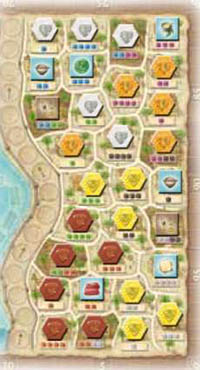
Punish markers: for each punish marker a player has in his player area, he moves his disc on the prestige track backward 3 spaces.
Building/Person cards: all activated cards that are marked "game end", take effect and the players move their discs on the prestige track according to the texts on these cards.
City scoring: each player scores points for his largest connected string of ownership markers in the city. For each marker in the string, the player scores two prestige points.
Example: for their largest ownership marker strings: yellow gets 6 PP; white gets 6 PP brown gets 12 PP, and orange gets 8 PP. (as the white player also has the activated cards smithy and statue, he gets an additional 5 and 3 PP).
The winner is the player who has moved furthest along the prestige track - earned the most prestige points.
If players tie with the most, the player among those who is further along the wall is the winner.
Continue Reading
